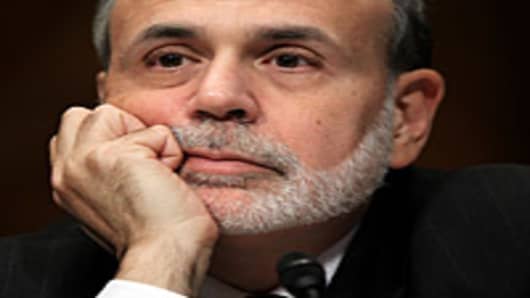With visions of more easing, investors will be looking over the minutes of the Federal Reserve’s last meeting on Wednesday, but they are unlikely to find a clear signal on the Fed’s policy intentions.
“Some members want more. Some members don’t want more,” said Peter Boockvar, a market strategist at Miller Tabak. “There’s a general confusion, and that’s exactly what we’ll see in the minutes, which also means that Bernanke might not be sure next week either, at Jackson Hole, and he will want to leave possibilities open.”
Just Tuesday, voting member Atlanta Fed President Dennis Lockhart said he wasn’t sure yet whether the Fed should embark on a new easing program, while last week San Francisco Fed President John Williams, also a voting member of the FOMC, said he believes the Fed should move. Dallas Fed President Richard Fisher, who cannot vote, disagrees and said he thinks the Fed should stand down.
The Fed had widely been expected to announce another round of quantitative easing at its meeting Sept. 12, but those expectations faded in recent weeks as some U.S. economic data was better than expected.
The market has also expected the Fed’s next QE program to include the purchase of mortgaged-backed securities or a blend of mortgages and Treasurys. The Fed’s July 31 meeting was held prior to the string of better-than-expected data, including the July employment report.
“You’re going to need a translator for these minutes,” said Art Cashin, director of floor operations at UBS. “Even if you thought you picked up a thread, you might hear people say that things have changed.”
Some Fed officials, including Fed Chairman Ben Bernanke, have made it clear the Fed will need to weigh incoming data in order to make its decision. Bernanke has said the Fed is ready to act if necessary, and it was expected he would signal the Fed’s intentions during the Fed’s annual symposium at Jackson Hole, Wyo., on Aug. 31, just as he did two years ago.
But now some Fed watchers believe Bernanke will have difficulty clearly stating the Fed’s view in Jackson Hole, and Fed officials will have to wait until the early September data, particularly the August employment report, to make a decision.
“How can you do QE when the S&P is at 1,400? The CRB index is at its highest level since April. Part of that is from the possibility of more Fed action,” Bookvar said.
The Thomson Reuters CRB measures price moves in 19 commodities.
Fed watchers are hoping, at the very least, to see some discussion of what tools the Fed is considering.
“Our estimation is the last FOMC meeting was more of a strategy session in which Fed members discussed policy tools at their disposal should economic conditions warrant further action,” said Deutsche Bank chief U.S. economist Joseph LaVorgna.
He said the options could include pushing out the targeted exit date for extremely low rates on Fed funds, cutting rates on reserves, and expanding the balance sheet more through QE asset purchases.
Market strategists say stocks were supported by the idea of Fed easing, but they were also lifted recently by the better economic reports.
LaVorgna said the upcoming Sept. 7 August employment report and the Aug. 29 release of the Fed Beige Book may be better clues as to Fed action in September. He said the Beige Book will provide a more important look inside the Fed’s thinking, as it will give details of the economy and whether the level of activity is at a place where the Fed would consider acting.
Besides the 2 p.m. EST Fed minutes release, existing home sales are reported on Wednesday at 10 a.m., and mortgage applications will be reported at 7 a.m.
“It’ll be important just because we’ve gotten some stabilizing housing data over the past month, outside of weekly mortgage applications. We need to see that tomorrow as well. In fact, mortgage applications could be more timely because existing home sales will measure contracts signed months ago,” Boockvar said.
Stocks fell Tuesday after the S&P 500 broke through its April intraday high of 1,422 and briefly traded at a four-year high of 1,426. The market reversed course and the S&P ended the day at 1,413, off 4 points. The Dow was off 68 at 13,203. Some stocks that had hit new highs reversed course and ended lower on the day. Apple, which became the biggest stock by market cap on Monday, lost 1.4 percent.
“It got into resistance at 1,423 to 1,426. So they stopped right at resistance,” Cashin said. “I’m sure a lot of it is we had a good run …The banks are trying to break out here. The question is, is that high volume a sign of exhaustion volume? We’ll find out in a day or two.”
“We’ll see the market couldn’t quite break out, and it’s either consolidating for another raid on the high, or maybe it’s just going to take some time off here,” he said.
Boockvar said the rally has been driven by the hopes for Fed easing, and possible action by the European Central Bank.
“Economic fundamentals don’t point to multi-year highs in the market,” he said.
Dell’s disappointing after the bell earnings news and lowered forecast could also be a factor for stocks on Wednesday. The stock fell in late trading. Wednesday’s earnings reports include Hewlett-Packard after the closing bell, but there are several interesting reports ahead of the open, including American Eagle Outfitters , Chico’s FAS and Toll Brothers , which will be another read on the housing market.
Follow Patti Domm on Twitter: @pattidommQuestions? Comments? Email us at marketinsider@cnbc.com




